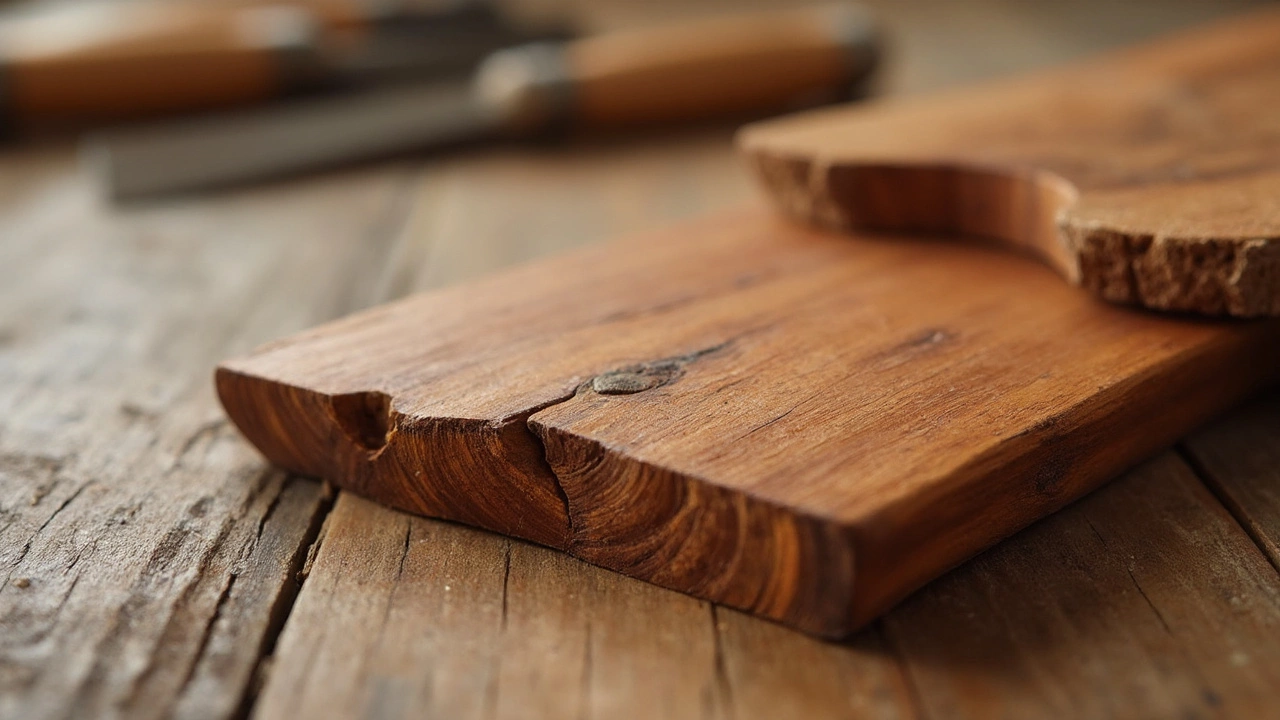
When it comes to making furniture in India, the strength of the wood really matters. Who doesn't want a dining table that lasts generations or a chair that can handle a good plop down? But how do you pick the right wood?
In India, there’s a treasure trove of woods that stand out for their strength and longevity. It's not just about picking the hardest wood but understanding what makes them unique. Let's take a look at some of the top contenders.
Teak is often the first name that pops up. Known as the 'king of woods,' it's famous for its durability and resistance to pests. Indian teak, especially from central regions, is robust and has natural oils that keep it looking good with minimal care. If budget isn't too tight, teak is a fantastic choice.
- Understanding Wood Strength
- Top Strongest Woods in India
- Teak: The Golden Choice
- Sheesham: The Durable Contender
- Practical Tips for Choosing Wood
- Sustainability and Ethical Sourcing
Understanding Wood Strength
So, what makes wood strong enough for furniture? It's a mix of things like density, hardness, and how well it stands up to stress. To get a clear picture, it's important to understand these aspects.
Density and Hardness
Density refers to how tightly the wood fibers are packed. The denser the wood, generally, it is stronger and heavier. When people talk about strongest wood India, density is a big part of the conversation.
Hardness, on the other hand, is typically measured by the Janka Hardness Test, which tells you how resistant a wood species is to wear and tear. A higher score means the wood is tougher. It's a handy way to figure out if a certain wood is up for the job, especially if you're thinking about furniture that gets a lot of use.
Durability and Resistance
Another key strength factor is durability. This is about how well the wood handles bugs, fungi, and weather conditions. Teak and Sheesham are awesome here; they naturally resist termite attacks and withstand humid conditions without much hassle.
Flexibility and Load Bearing
But strength isn't just about not breaking. Flexibility matters, too. Some woods can bend without snapping, which can be a huge plus for certain designs. Load-bearing capacity is crucial if you're planning to build something that needs to support weight, like a bookshelf full of heavy items.
All these aspects blend into what we call the wood's structural integrity, vital for any serious furniture project. Knowing your wood's strength can save you a lot of trouble and money in the long run.
Top Strongest Woods in India
India's vast and varied landscape is home to some pretty impressive woods, each with unique qualities making them the top picks for furniture wood India. Here we'll dive into the strongest contenders and why they’re the top choice for any furniture enthusiast.
Teak Wood
Teak is often hailed as the go-to for durability. It's almost synonymous with luxury furniture due to its rich color and resilience. Besides being one of the strongest, its natural oils make it highly resistant to rot, insects, and harsh weather conditions. Not to mention, it ages beautifully, developing a unique patina over time. This wood is nothing short of a furniture maker's dream.
"Teak from India is globally recognized for its strength and grain, making it ideal for high-end furniture," says Arjun Mehta, a renowned furniture designer based in Bengaluru.
Sheesham Wood
Next up, we have Sheesham, also known as Indian Rosewood. It's a favorite due to its hardiness and beautiful grain patterns, making every piece of furniture unique. The wood is heavy and dense, meaning that anything crafted from Sheesham is sure to last. It's also relatively easier on the wallet compared to teak, offering a great balance of beauty and budget.
Satinwood
If you’re looking for a bit of sheen, Satinwood might catch your eye. It’s almost as hard as teak, with a glossy finish that brings a sophisticated touch to any furniture piece. Although slightly more demanding in maintenance, its striking appearance makes it worthwhile.
Acacia Wood
Don’t overlook Acacia, which is fast gaining popularity due to its high strength and eco-friendly nature. Not only is it one of the toughest, but it's also sustainable – growing quickly and in abundance. This makes it a smart choice for the environmentally conscious furniture maker.
Here’s a quick comparison to help you out:
| Wood Type | Durability | Resistance | Cost |
|---|---|---|---|
| Teak | High | Very High | High |
| Sheesham | High | High | Moderate |
| Satinwood | Moderate | Moderate | Moderate |
| Acacia | High | Moderate | Moderate |
In the end, the choice boils down to what suits your needs and style. Whether it’s the classic appeal of teak or the unique grain of Sheesham, the toughest woods in India offer something for every taste and requirement.
Teak: The Golden Choice
If you're diving into furniture making in India, teak is like hitting the jackpot. It's not just because everyone calls it the 'king of woods'. There's so much that makes it a top pick.
First off, let's talk about resilience. Teak wood's innate resistance to pests and water is legendary. It naturally sports oils that keep it from warping and dodges those troubling termites with ease. That’s a 'peace of mind' thing for anyone looking to build something that'll last.
Where Does It Come From?
In India, vast tracts in states like Kerala, Karnataka, and Madhya Pradesh boast some high-quality teak. Sourced responsibly, these regions provide the good stuff—sturdy, reliable, and with that lovely golden-brown sheen that's almost impossible to resist.
Why Choose Teak?
Now, you might be thinking about your wallet. Sure, teak isn't the cheapest out there, but let's look at the bigger picture:
- Durability: Expect furniture that stands the test of time. Think of it as an investment.
- Easy Maintenance: Thanks to those natural oils, the upkeep is pretty low-key. A regular wipe down is usually all it takes to keep teak looking sharp.
- Aesthetic Appeal: That classic, warm look fits right into most decors, modern or traditional.
For those who love details, here's a quick glance at where teak stands out:
| Characteristic | Benefit |
|---|---|
| Natural Oils | Preserves wood texture |
| Dense Hardness | High resistance to wear |
In short, if you're in the market to create indoor or outdoor furniture that blends both beauty and toughness, teak is definitely worth considering. Its enduring qualities make it an all-time favorite, ensuring your pieces stand tall in both style and strength.

Sheesham: The Durable Contender
When on the hunt for a solid option in Indian furniture making, Sheesham wood, also known as Indian Rosewood, comes into the spotlight. It's not just famous for its strength; it also boasts a beautiful grain that adds aesthetic value to any piece of furniture.
Why Sheesham Stands Out
Sheesham is a hardwood, making it incredibly durable and resistant to termites. This quality makes it an ideal choice for both indoor and outdoor furniture. It’s particularly popular in the northern parts of India, where its density and durability thrive in varied climates.
A true contender among woods, Sheesham is not just about toughness. Its natural color varies from golden brown to a rich dark brown, often displaying elegant rosy and reddish veins. This distinctive color makes it a top pick for those who want their furniture to have a natural and unique look.
Applications of Sheesham
- Dining tables – offering both beauty and strength.
- Cabinets and drawers – combines aesthetic appeal with robust usability.
- Decorative veneers – thanks to its beautiful grain and varied colors.
Working with Sheesham offers the advantage of a wood that carves and finishes nicely, leaving furniture makers with a product that’s easy to work with yet extremely affordable compared to teak.
Sourcing and Considerations
It's crucial to ensure ethical sourcing. Like many woods, Sheesham has faced challenges with illegal logging. Checking certifications or dealing with trusted suppliers can help ensure that your furniture wood is both sustainable and eco-friendly.
Practical Tips for Choosing Wood
Picking the perfect wood for your furniture isn't just about the looks. Let's dig into practical tips to select strongest wood in India that suits your needs.
Consider the Purpose
Start with understanding what the piece is meant for. A bookshelf needs different properties compared to outdoor garden furniture. For something indoors, aesthetics can play a bigger role. However, for outdoor items, look for woods like teak that withstand weather changes.
Density and Durability
Weighing up density is crucial. Denser woods tend to be stronger. For instance, Sheesham and Teak are heavy and less prone to wear and tear.
Budget Conscious Choices
Your wallet can dictate terms. Teak is premium but pricey. If you’re watching your expenses, look at options like Sheesham or Sal wood, which offer bang for the buck without sacrificing strength.
Local Availability
Go local! Checking the local timber market may reveal efficient and cost-effective options. Avoid imported woods unless you’re after something very specific.
Sustainability Matters
Consider woods sourced ethically. Certification from Forest Stewardship Council (FSC) is a good sign. It ensures you’re not contributing to deforestation.
Testing for Toxin Resistance
Some woods naturally repel pests. Teak, with its natural oils, is resistant to termites. If that’s a concern you have, keep this factor in mind.
Quick Reference: Wood Properties
| Wood Type | Density(kg/m³) | Cost |
|---|---|---|
| Teak | 655 | High |
| Sheesham | 750 | Medium |
| Sal Wood | 800 | Low to Medium |
Remember, choosing the right wood is as much about knowing your needs as knowing your wood types. Weigh factors carefully and you’ll build something to stand the test of time.
Sustainability and Ethical Sourcing
When we talk about the strongest wood in India, it’s crucial to think about how it's sourced. With deforestation on the rise, choosing sustainably sourced wood is more important than ever. It’s not just about quality; it’s about ensuring these trees are around for future generations.
So, what makes wood sustainable? First off, it's all about responsible forest management. This means logging in a way that allows forests to regenerate and maintain their biodiversity. In India, there are initiatives that support sustainable forestry and help communities with reforestation projects. Buying wood certified by organizations like the Forest Stewardship Council (FSC) ensures that your wood is coming from responsibly managed forests.
Look for Certifications
Certifications are your friend. They’re the easiest way to make sure you're not part of the deforestation problem. Products with FSC or Green Guard labels indicate a commitment to sustainability. So, check those tags before you buy.
Support Local Communities
Another part of ethical sourcing is community support. Many Indian wood types, like Sheesham, are harvested by local communities who depend on this trade for their livelihood. By buying ethically sourced wood, you're not just getting a tough and reliable product; you’re also supporting these communities.
The Role of Technology
Tech is also helping out. New tracking systems allow customers to trace the journey of their wood from forest to furniture. This transparency builds trust and helps buyers make informed decisions.
Benefits of Choosing Sustainably
- You support the regeneration of forests, which is a win for nature.
- It ensures that rare species aren't over-harvested, maintaining biodiversity.
- There's a positive social impact by supporting fair trade practices in local communities.
| Certification | Key Benefit |
|---|---|
| FSC | Ensures responsible forestry |
| Green Guard | Indicates low chemical emissions |
By paying attention to sustainability and ethical sourcing, you ensure that the furniture you make not only looks good and lasts long, but also contributes positively to the environment and society. It’s a small step that makes a big difference.